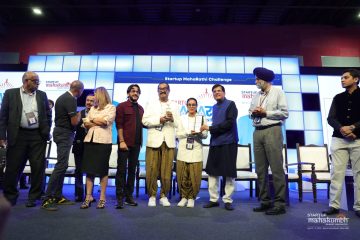Albert Einstein had once said, “If you can’t explain it to a six-year-old, you don’t understand it yourself.”
But the challenge of scientists, health workers and the administrative machinery, involved in communicating health awareness and promoting the adoption of new health habits, to large segments of people with varying levels of education and exposure remains an arduous task. In a diverse country like India which has close to 65% of the population living in a rural or semi-urban setup, 30% population devoid of literacy in addition to significant school drop-out rates, rural health communication, particularly in the pandemic situation, demanded novel and localized approaches with scientific ideas explained in the most elementary form.
Recently IIT Kharagpur took up this challenge to improvise an effective method of health communication to a large catchment of the rural population. Under the project “Folk Artists in the Time of Coronavirus” funded IIT Kharagpur, Prof. Anjali Gera Roy, from the Dept. of Humanities and Social Sciences, engaged with folk artists (Patua) from the Naya village in West Midnapore to hold COVID-19 awareness outreach initiative communicated through visual and musical art forms.
The tradition of creating public awareness programs started among the Naya Patuas two decades back with a group of women led by Rani Chitrakar performing on the HIV AIDS issue. Prof. Anjali Gera Roy, who has been working with this community approached a group of Patuas from Naya to create scroll paintings and songs exclusively to promote hygiene habits among the local people around Kharagpur. While the Institute has been organizing relief camps for the distribution of essential items to the underprivileged community, several of the relief recipients were observed to be nonchalant with regards to hygiene habits such as wearing masks or maintaining social distance despite the Institute repeatedly urging the people to follow the health protocols.
This is where the group of Gurupada Chitrakar, Bahadur Chitrakar, Swarna Chitrakar, Jaba Chitrakar and Sonali Chitrakar were brought in to tell the tale of COVID-19. Guided by IIT Kharagpur researchers, the Patua group composed their songs in local dialects along with scroll paintings in folk art format to help the audience understand the challenges of COVID-19 and best practices to be adhered to. This mode of communication makes scientific information palatable and cognizable to people in various sections of society, especially in the area of health. The threat perception, precaution and remedies, when communicated in a language hued in cultural connotations, and coming from their social peers, is easier for the local people to connect with and efficacious in their public compliance.
The first performance was organized at the entry gate of the IIT Kharagpur campus. [Watch Video] As the relief recipients queued outside the IIT gate, a Patua group from Naya engaged them in an interactive session about COVID-19. They followed it with a performance of songs to pats or scrolls created by the Patuas on the theme. The painters drilled home warnings about not following lockdown rules and other instructions through their pictures and songs and exhorted the onlookers to fight together to defeat the virus.
Talking about the initiative, Prof. Anjali Gera Roy remarked, “This form of communication to the underprivileged community has been a tradition and has proven to be effective for ages. We are mulling over organizing more such performances for various sections of the society, especially to promote the vaccination drive.”
The people who came to collect the relief materials expressed awe not only in the artwork but the information being disseminated through folk music by their fellow community members. Many of the spectators explored the paintings to understand the nature of coronavirus and COVID-19.
Gurupada Chitrakar, a Patua performer said, “We find the medium of songs and pictures more effective than words. When we came to IIT Kharagpur and stood in a line arranging our pats, people begin to wonder what on earth are they going to do. But when we started singing, gradually people cocked their ears listen carefully and wanted to see the pictures and listen to the songs. Those standing in the queue began to pay attention to whether they were standing too close or lowering their masks even though they know about COVID already.”
Recently, IIT Kharagpur had conducted a joint exhibition with Gurudev Tagore Indian Cultural Center (GTICC) Indian Council For Cultural Relations, India In Mexico (Embassy of India, Mexico City) and OraWorld Mandala to present an online workshop and symposium titled “Life on Scroll: Lockdown Creativity” by scroll painters and folk artists in India and Mexico. The highlight of this exhibition was a visual representation of COVID-19 in Patua art, short films on Amate and Huichol art and interactions of the Patuas from Naya with the Amate artists and Huichol/Textile painters from Mexico.
Read the story on Times of India



